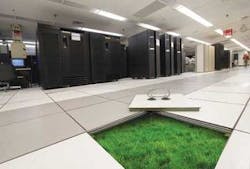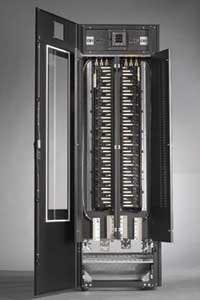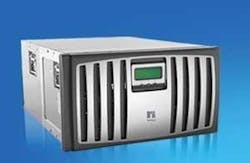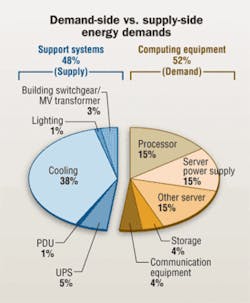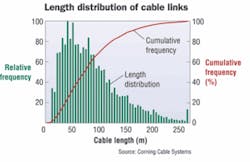The EPA’s Energy Star specification will help reduce power consumption in the data center, among many other key strategies.
by Betsy Ziobron
As a follow up to August 2007’s “Report to Congress on Server and Data Center Energy Efficiency” (summarized in “Inside the EPA’s Energy Efficiency Report,” Cabling Installation & Maintenance, February 2008, page 27), the U.S. EPA recently released the Draft 1 Energy Star specification for computer servers. Some of the key eligibility criteria for Energy Star servers will likely include power supplyefficiency, power management, virtualization capabilities, and real time power and temperature measurement during server operation.
And while Energy Star will help drive energy efficiency in the data center, it’s just one of many strategies that will ultimately reduce power consumption.
The ‘star’ treatment
“The EPA has realized that energy has an impact on our economy and our foreign policy,” says Andrew Fanara, Energy Star product specifications development team leader (www.energystar.gov). “Layered on top of that is a growing concern about the impact on the environment. Our goal is to use programs like Energy Star to encourage efficient use of energy, and we’ve done this already in nearly 14 other major product categories.”
Fanara points out that Energy Star products for desktop equipment, such as PCs, monitors, laptops, printers, and copiers, have been around for a while. But the development of Energy Star specifications for data center products was one of several noteworthy policy recommendations in last year’s report to Congress. TheEPA hopes to finalize the specifications for Tier 1 data centers before the end of this year.
According to Fanara, the decision to adopt Energy Star for data center equipment was an easy one: “We’re continually hearing from commercial companies that utilitybills are growing, and data centers are responsible for 60 to 70% of the cost. Because they are an intensivespace with an increasing demand for the services they provide, the data center market has risen to the point where it now shows up on the radar screen as an actual market sector.”
Fanara continues, “The government also has a vested interest in these facilities because they are our nation’s vital computing backbone. Whether they’re small closets or server farms; whether they’re in the public or privatesectors; whether they’re figuring out the human genome, enablingonline banking, or managing the social security administration, data centers collectively are at the very core of our world.”
With today’s data center deploying more equipment than ever,power consumption per square foot is at an all-time high. The Energy Star program for data center equipment will help to reduce power consumption, but the EPA knows that it’s just a small piece of the puzzle.
“We can look to Energy Star for servers, storage systems, and routers as a first step in reducing the amount of heat generated and power and cooling needed,but there are many strategies in the middle,” says Fanara.“It’s important to look at the entire data center as a whole.Just tracking and managing the deployment of equipmentcan save substantial amounts of money. Some data centermanagers add new servers and run applications, but when the application is no longer in use, the servers are left pluggedin and become orphans that nobody wants to touch.”
Power play
From power distribution and management to proper load sizing and implementing advanced UPS technologies, many power infrastructure options are available to further reduce consumption in the data center. Forexample, in the typical commercial building, 480-volt power provided by the UPS is quickly stepped down to 208 volts in the power distribution unit (PDU), whichresults in step-down losses. Converting UPS output power to 415 volts and operating equipment at higher voltages can eliminate those losses and achieve energy savings, which is a common practice in Europe.
“There are significant efficiency gains to be had if we bring higher voltage as close to the equipment as possible and run servers, storage equipment, and switches at 240 volts instead of 208 volts,” explains Jack Pouchet, director of energy initiatives with Emerson Network Power (www.emerson.com). “Servers and other IT equipment can handle 240 volts AC input, but it’s just not common practice. By going to a higher voltage distribution, more power can be carried over the same amount of copper, saving cabling costs and improving efficiency. It’s a win-win for everybody.”
In response to energy savings gained from higher power distribution, Emerson Network Power released a new LiebertFDC 480V power distribution cabinet that cosmetically blends with rack equipment and works in conjunction with a UPS to deliver480 volts closer to the load.
Pouchet also points out the need for data center managers to size their power infrastructures based on actual load: “If there’s one thing that everyone needs to understand, it’s that the faceplate UL rating on equipment is erroneous at best. The UL rating is based on worst-casescenario, and if you ask the manufacturer for the actual rating or measure what it’s drawing, most find out that their equipment isn’t drawing anywhere near what they thought it would.”
Emerson Network Power also offers scalable Liebert NX UPS that operates at 97% efficiency. Using Softscale software technology, the Liebert NX can be sized to current requirements and then scaled up with a simple software key. “This technology allows data center operators to better match the UPS to the actual load and only add capacity when needed, rather than oversizing,” says Pouchet.
Power management at the server level, as required in the Draft 1 Energy Star specification for computer servers, allows aserver to automatically detect how it’s running in terms of performance and capacity. If the server is running at a lower capacity, power management throttles back to a much lower power consumption state.
“It’s sort of like using a dimmer switch to turn down the lights when you don’t need as much light,” explains Pouchet. “Unfortunately, the average data center operator is more concerned with rolling out the next application and maintaining avail- ability than worrying about whether they have 50 servers sitting idle. Instead of running 10,000 servers all the time at the maximum power level, they could use power management on just half those servers to reduce power consumption during non-peak times, like weekends and holidays. Power management can cut consumption by one-third.”
Some newer servers include new UPS technology designed to be more efficient at a lower load. “The UPS we offer at the server level actually trails off in efficiency as you get close to full load,” says Pouchet. “We do this because we know that most don’t run at full load for any long period of time.”
Don’t lose your cool
While cooling is directly related to the amount of heat generated by equipment, CRAC (computer room air conditioning) units consume a lot of power, and inefficient cooling can also be a huge waste of energy.
“I’ve seen a $1 temperature gauge stuck on a rack that reads 88 degrees,” says Jeff Powers, senior product manager with Emerson Network Power Liebert Service (www.liebert.com). “We find temperature swings from the 50s to the 90s in the same room, and just because the room itself is cold, doesn’t mean that the equipment in the rack is being kept cool. The last thing you want to do is cool the open space of a data center—it’s a huge waste of energy.”
Many data center managers are under the impression that the cooler you keep the data center, the longer the equipment will last. But with most equipment being refreshed every three years, cooling experts believe that maintaining 70 degrees is adequate.
“Data centers don’t need to be 64 or 65 degrees,” says Pouchet. “I’ve been through more data centers that feel like meat lockers, with heaters being used under the desks of those that work in there. Moving the temperature up to 70 degrees is a good practice.”
Pouchet adds, “It’s also 30 to 50% more efficient to use in-row or rack-based cooling rather than throwing more CRAC units around the room. Data center managers need to learn to focus cooling where they actually need it.”
Virtual reality
The need to reduce heat and power consumption and improve management has led to server virtualization, which allows multiple applications to run on a single piece of equipment. Virtualization uses software to partition a server into logical segments, and it can be run on a variety of today’s servers. In the average enterprise-class Tier 1/Tier 2 data center, virtualization can bring server efficiency from 15% up to 80 or even 90%.
“Server virtualization is white hot and growing like crazy,” observes Chris Bennett, vice president of core systems for NetApp (www.netapp.com). “It originally started due to economics—it was a means to control growth, improve management, and cope with space limitations by limiting the number of physical servers that have to be deployed in a data center. Virtualization makes good business sense, and it’s good stewardship. It’s a happy coincidence that doing something that makes good economic sense also greatly reduces power consumption.”
Bennett adds, “It’s sort of like having a 200-horse-power car—the only time I’m going to use a significant fraction of that is when I’m accelerating like crazy, and most of the time, the engine is running at a much smaller fraction of its potential. Virtualization averages out all the peakdemands among the applications running on one server, allowing the physical asset to run more efficiently.
With servers representing 50 to 60% of the total power consumption in the data center, Bennett says, “having as few servers as possible is key to reducing that power consumption. Plus, the more equipment you have, the more heat you generate and the more cooling you need.”
In the coming months, the Energy Star program will be setting criteria for storage equipment, which currently encompasses about 20 to 30% of data center power consumption and is growing as data expands. The August 2007 EPA Report to Congress referred to the need for more efficient storage devices that use features like storage virtualization and data de-duplication, which are currently available from some vendors.
“Just like with server virtualization, we use software to partition a single pool of storage disks into logical chunks rather than deploying a vast array of disks that are underutilized,” says Bennett. “De-duplication makes a logical copy of the data rather than making multiple physical copies that require more disk space, allowing only the changes made to be stored. The new object then points back to the original information.”
NetApp’s Fabric-Attached Storage (FAS) systems deployde-duplication technology, plus other features that make the equipment far more energy efficient. FAS systems enable flexible thin provisioning, which let data center managers allocate only the amount of storage they need at a given time rather than costly over-allocation and time-consuming reconfiguration.
“We’ve also changed the rules on the kinds of media that can be used,” Bennett says. “Storage has traditionally been accomplished on high performance Fibre Channel drives, but higher capacity SATA [Serial Advanced Technology Attachment] drives consume about 50% less power and offer the highest available storage density per drive. SATA drives were additionally thought of as only useful for long-term archive with lower performance, but new advancements are allowing them to be used for many more applications than originally thought possible.”
More to come
In addition to Energy Star ratings for data center equipment, which will help level the playing field and drive competition on the basis of efficiency, the EPA is also working to implement standardized metrics for measuring and reporting data center efficiency. Standard metrics will provide the baseline for managers to determine and compare efficiency among data centers.
“Many data centers today are not separate metered facilities, but that’s something that can be easily changed,” says EPA’sFanara. “We’re working with utilities to do that. Data centers are too important to try and use green power like windmills and solar energy right now, although we’d eventually like to grow into those alternatives. Efficiency is really the first step and the cheapest. We think data center managers can get the biggest bang for their buck by just better operating and managing the data center, and then we can add procurement of Energy Star equipment on top of that.”
According the Fanara, the program will address most of the typical enterprise-class products on the market, which is where the bulk of the products are being sold. “Most vendors feel they are up to the challenge of meeting Energy Star,” he says. “And the incentives are already there—Wal-Mart is nothing more than stores that sit on top of a world-class supply chain that can’t function without the data center. FedEX can’t be effective without the algorithms that enable every truck to make right hand turns instead of left to minimize wasted time. It’s all driven by the data center, and the cost of operating these facilities is becoming a huge concern.”
Experts expect to see more efforts underway to furtherreduce power consumption in the data center. On March 19, EPA teamed up with the U.S. Department of Energy to initiate a voluntary National Data Center Energy Efficiency Information Program that coordinates a wide variety of activities from the DOE and EPA.
“In the second or third quarter of this year, Emerson Network Power will launch a new website (www.efficientdatacenters.com) to provide moreeducation to the IT community,” says Emerson’s Pouchet.“A lot of great information is also coming out of The Green Grid [www.greengrid.com], and I encourage data center managers to get involved. In addition, the U.S. Green Building Council has agreed to include data centers along with the LEED standards for laboratories and cleanrooms, with the goal to gain more LEED points for energy efficient practices in the data center.”
Pouchet concludes, “We’re very excited about the level of commitment across the industry.”
BETSY ZIOBRON is a freelance writer and regular contributor to Cabling Installation & Maintenance. She can be reached at: [email protected]
Is your data center efficient?
Standardized metrics will help drive the measuring ofdata center efficiency, but until they are available, data center managers can still conduct assessments today.
Many consultants and companies, including Emerson Network Power (www.emerson.com) and NetApp (www.netapp.com), offer assessment services to help managers determine whether their data center is efficient and can provide recommendations for lowering costs and eliminating vulnerabilities.
Liebert Service, a division of Emerson Network Power, was started in the late 1980s to service Liebert cooling and power products. Since then, it has expanded into a full data center assessment service that identifies hot spots, resolves power and cooling inefficiencies and problems, and ensures proper capacity.
“We typically send in two or more engineers that go through a huge data gathering process,” explains Omar McKee, manager of service solutions for Emerson Network Power Liebert Service (www.liebert.com). “They meet with the customer to gather as much qualitative information as possible about their operations and business objectives, and then they literally map out the space with a detailed data center floor plan and information about all the equipment, including capacity, temperature, airflow, load ratings, etc.”
McKee says the information is then “put through a computational fluid dynamics analysis to provide 3D renderings that model temperature and airflow, show the customerexactly what’s in their space, and make recommendations to solve power and cooling issues, improve efficiency, and provide guidelines for future growth.”
In addition to capacity and efficiency, the data center assessmentincludes everything from checking the height of the raised floor, cabling, and airflow obstructions to hot aisle/cold aisle configurations, safety concerns, and grounding and bonding.
“It’s hard to pinpoint a single common issue that we see with data center assessments—it’s really a culmination of many problems, and the issues are the same across vertical markets and geographies,” says Jeff Powers, senior product manager, Emerson Network Power Liebert Service. “The one issue we find time and time again is the lack of knowledge of what equipment is actually in the data center and what it’s doing.”—BZ
